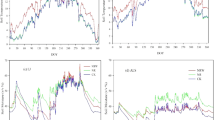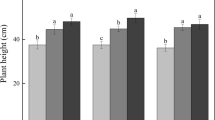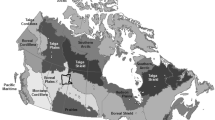Abstract
CH4 and CO2 fluxes from a high-cold swamp meadow and an alpine meadow on the Qinghai-Tibetan Plateau, subject to different degrees of degradation, were measured over a 12-month period. Air temperature, soil temperature and moisture, and the depths of the water table and thawing-freezing layer were determined. For swamp meadows, the greater the degradation, the lesser the carbon efflux. CH4 emissions at the nondegraded swamp meadow site were 1.09–3.5 and 2.5–11.27 times greater, and CO2 emissions 1.08–1.69 and 1.41–4.43 times greater, respectively, than those from moderately and severely degraded sites. For alpine meadows, the greater the degradation, the greater the CH4 consumption and CO2 emissions. CH4 consumption at the severely degraded alpine meadow site was 6.6–21 and 1.1–5.25 times greater, and CO2 emissions 1.05–78.5 and 1.04–6.28 times greater, respectively, than those from the nondegraded and moderately degraded sites. The CH4 and CO2 fluxes at both sites were significantly correlated (R 2 > 0.59, P < 0.05) with air temperature, soil temperature, and topsoil (0–5 cm depth) moisture, indicating these to be the main environmental factors affecting such fluxes.








Similar content being viewed by others
References
Castro MS, Steudler PA, Melillo JM et al (1995) Factors controlling atmospheric methane consumption by temperate forest soils. Global Biogeochem Cycles 9:1–10
Chen J, Yamamura Y, Hori Y et al (2007) Small-scale species richness and its spatial variation in an alpine meadow on the Qinghai-Tibet Plateau. Ecol Res. doi:10.1007/s11284-007-0423-7
Dasselaar A, Beusichem ML, Oenema O (1998) Effects of soil moisture content and temperature on methane uptake by grasslands on sandy soils. Plant Soil 204:213–222
Duan AM, Wu GX, Zhang Q et al (2006) New proofs of the recent climate warming over the Tibetan Plateau as a result of the increasing greenhouse gases emissions. Chin Sci Bull 51(11):1396–1400
Gao XS, Tian ZC, Hao XN (2006) The changes of alpine grassland soil nutrition at different deteriorate degree on high mountain meadow of three river source. J Qinghai Univ (Nat Sci) 24(5):37–40
Gulledge J, Schimel JP (1998) Moisture control over atmospheric CH4 consumption and CO2 production in diverse Alaskan soils. Soil Biol Biochem 30:1127–1132
IPCC (Intergovernmental Panel on Climate Change) (2001) Climate change 2001: the scientific basis. IPCC, Paris
Jia BR, Zhou GS, Wang FY (2005) Affecting factors of soil microorganism and root respiration. Chin J Appl Ecol 16(8):1547–1552
Jones SK, Rees RM, Skiba UM et al (2005) Greenhouse gas emissions from a managed grassland. Glob Planet Change 47:201–211
Kravchenko Irina K (2002) Methane oxidation in boreal peat soils treated with various nitrogen compounds. Plant Soil 242:157–162
Lena S, Mikhail M, Torben R (2005) Species-specific effects of vascular plants on carbon turnover and methane emissions from wetlands. Biochemistry 75:65–82
Li WH, Zhou XM (1998) Ecosystems of Tibetan Plateau and approach for their sustainable management. Guangdong Science and Technology Press, Guangdong
Li YF, Lai DZ, Zhou MX (1999) Rat and insect controls in grassland of Guoluo prefecture. Chin Qinghai J Anim Vet Sci 29(4):16–17
Liu SZ, Zhou L, Qiu CS (1999a) The study on meadows degradation and desertification in the Naqu Prefecture of Tibet (in Chinese). Tibetan People Press, Lhasa, pp 36–69
Liu W, Wang QJ, Zhou L (1999b) Ecological process of forming “black-soil-type” degraded grassland. Acta Agrestia Sin 7(4):300–307
Liu LX, Dong YS, Qi YC (2004) The development on the soil respiration of grassland ecosystem (in Chinese). Prog Geogr 23(4):35–42
Ma YS, Lang BN, Wang QJ (1999) Review and prospect of the study on “black soil type” deteriorated grassland. Pratacultural Sci 16(2):5–9
Maljanen M, Hyonen J, Martikainen P (2001) Fluxes of N2O, CH4 and CO2 on the afforested boreal agriculture soils. Plant Soil 231:113–121
Margaret R, John A (2006) Net carbon exchange and evapotranspiration in postfire and intact sagebrush communities in the Great Basin. Oecologia 146:595–607
Mosier A, Schimel D, Valentine D et al (1991) Methane and nitrous oxide fluxes in native, fertilized and cultivated grasslands. Nature 350:330–332
Ni J (2002) Carbon storage in grasslands of China. J Arid Environ 50:205–218
Oechel WC, Hastings SJ, Vourlitis GL et al (1993) Recent change of Arctic tundra ecosystems from a net CO2 sink to a source. Nature 361:520–523
Pen-Mouratov S, Rakhimbaev M, Steinberger Y (2006) Spatio-temporal effect on soil respiration in fine-scale patches in a desert ecosystem. Pedosphere 16(1):1–9
Robertson GP, Paul EA, Hardwood RR (2000) Greenhouse gases in intensive agriculture: contribution of individual gases to the radiative forcing of the atmosphere. Science 289:1922–1925
Shi DJ, Li XL, Yang LJ (2006) The characteristics and restoring strategy of “Heitutan” grassland communities in different degrading degrees (in Chinese). Pratacultural Sci 23(7):1–3
Song CC, Yan BX, Wang YS et al (2003) Fluxes of carbon dioxide and methane from swamp and impact factors in Sanjiang Plain, China. Chin Sci Bull 48(24):2749–2753
Tan YR, Pu XP, Zhang DG (2006) The research on the soil enzymatic activities of meadows with different degradation (in Chinese). Grassland Turf 3:20–22
Wang GX, Cheng GD (2001) Characteristics of grassland and ecological changes of vegetations in the sources regions of Yangtze and Yellow rivers. J Desert Res 21(2):101–107
Wang Y, Wang Y (2003) Quick measurement of CH4, CO2 and N2O emission from a shortplant ecosystem. Adv Atmos Sci 20:842–844
Wang GX, Cheng GD, Shen YP et al (2001) Research on ecological environmental changes in Changjiang-Yellow rivers source regions and their integrated protection (in Chinese). Lanzhou University Press, Lanzhou
Wang GX, Cheng GD, Shen YP (2002) Soil organic carbon pool of grasslands on the Tibetan Plateau and its global implication. J Glaciol Geocryol 24(6):693–700
Wang GX, Guo XY, Shen YP (2003) Evolving landscapes in the headwaters area of the Yellow River (China) and their ecological implications. Landsc Ecol 18:363–375
Wang GX, Wang YB, Kubota J (2006a) Land-cover changes and its impacts on ecological variables in the headwaters area of the Yangtze River, China. Environ Monit Assess 120:361–385
Wang WY, Wang QJ, Wang HC (2006b) The effect of land management on plant community composition, species diversity, and productivity of alpine Kobersia steppe meadow. Ecol Res 21:181–187
Wang JF, Wang GX, Wang YB et al (2007) Influences of the degradation of swamp and alpine meadows on CO2 emission during growing season on the Qinghai-Tibet Plateau. Chin Sci Bull 52(18):2565–2574
Wei XH, Yang P, Li S (2005) Effects of over-grazing on vegetation degradation of the Kobresia pygmaea meadow and determination of degenerative index in the Naqu Prefecture of Tibet (in Chinese). Acta Prataculturea Sin 14(3):41–49
West AE (1999) Landscape patterns of CH4 fluxes in an alpine tundra ecosystem. Biochemistry 45:243–264
Zhang DQ, Shi PL, Zhang XZ (2005) Some advances in the main factors controlling soil respiration (in Chinese). Adv Earth Sci 20(7):778–785
Zhao YH, Wu TY (2006) Variation of CO2 concentration in active layer in Beiluhe permafrost region of the Tibetan plateau during winter and spring, 2005 (in Chinese). J Glaciol Geocryol 28(2):183–190
Zhao L, Li YN, Zhao XQ et al (2005) Comparative study of the net exchange of CO2 in types of vegetation ecosystems on the Qinghai-Tibetan Plateau. Chin Sci Bull 50(16):1767–1774
Zhou HK, Zhou L, Zhao XQ (2006) Stability of alpine meadow ecosystem on the Qinghai-Tibetan Plateau. Chin Sci Bull 51(3):320–327
Acknowledgements
This work was supported by the National Basic Research Program of China (973 Program) (grant No. 2007CB411504), the 100 Talents Programme of the Chinese Academy of Sciences (Project No. 2004), the Outstanding Youth Foundation Project, the National Natural Science Foundation of China (No. 40625004) and the National Nature Science Foundation of China (Project No. 90511003).
Author information
Authors and Affiliations
Corresponding author
Rights and permissions
About this article
Cite this article
Wang, J., Wang, G., Hu, H. et al. The influence of degradation of the swamp and alpine meadows on CH4 and CO2 fluxes on the Qinghai-Tibetan Plateau. Environ Earth Sci 60, 537–548 (2010). https://doi.org/10.1007/s12665-009-0193-3
Received:
Accepted:
Published:
Issue Date:
DOI: https://doi.org/10.1007/s12665-009-0193-3




